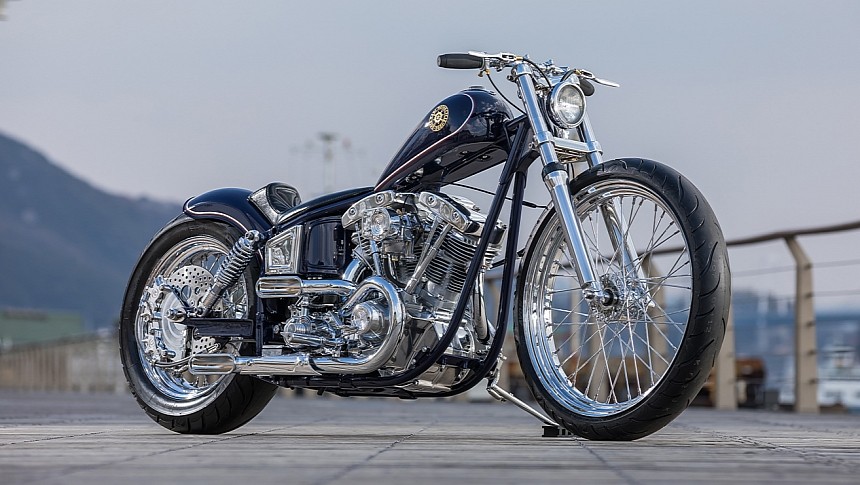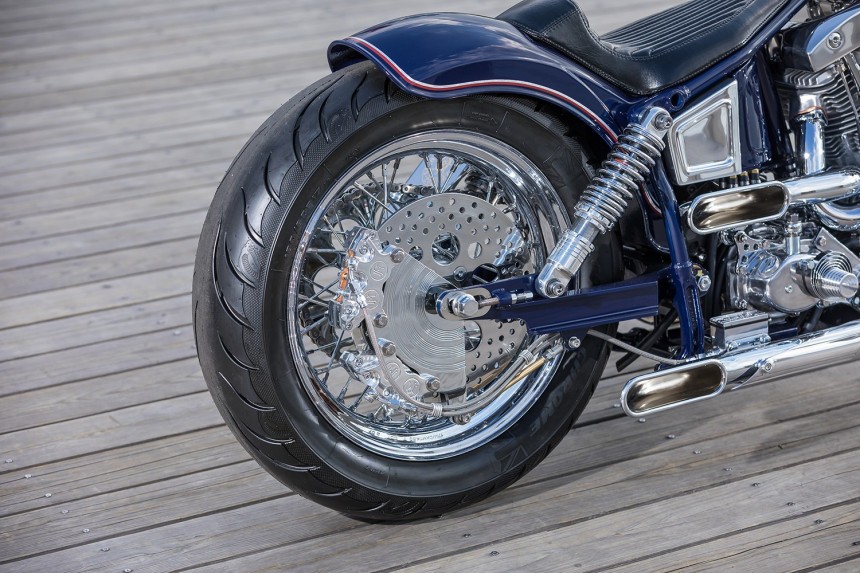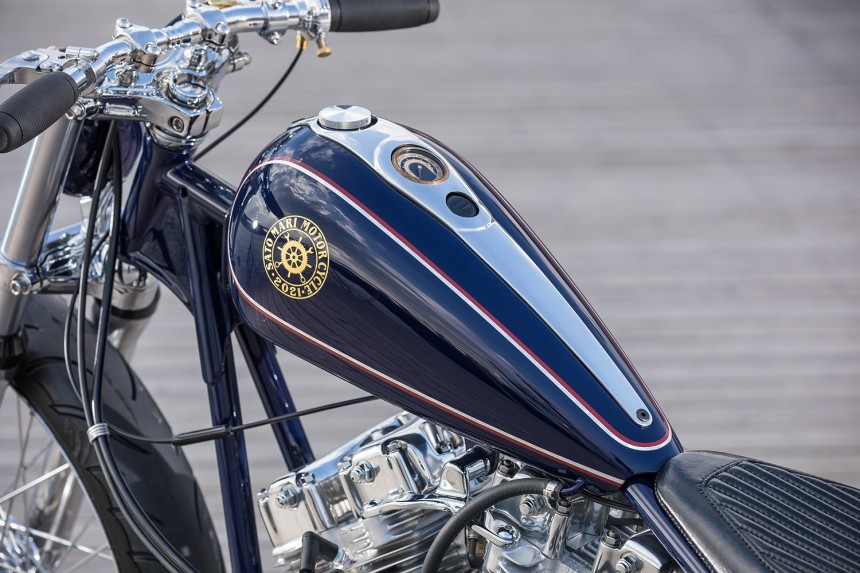As one of Japan’s most prolific bike builders and a regular visitor at the Yokohama Hot Rod Custom Show, Yusaku Sato is a true master of his craft. He’d gotten into motorcycles at a very young age, already taking part in local motocross events when he was in still elementary school. Many years later, Yusaku-san went on to establish his own repairs shop in the port city of Onomichi, Japan.
The firm began indulging in custom projects some time after its founding, and it wasn’t long until a team of skilled artisans joined our protagonist’s cause. Currently operating as Satomari Motorcycle, Yusaku and his crew have a strong affinity for one marque in particular, that being Harley-Davidson. American V-twins customized in Japan are by no means uncommon, but those built by Satomari are in a league of their own.
Most of them are based on classic hogs, and the one we’re about to look at is no exception. This stylish bobber holds a 1982 Shovelhead powerplant at its core, while the rest of its equipment was either built from scratch, taken off other Harleys, or sourced from top-tier aftermarket suppliers. Basing the project on a 1982 model was the only request put forward by the client, so everything else was left up to Satomari’s bright minds.
They took careful measurements of the old Shovelhead motor, which were then used to fabricate an entirely new frame in-house. The custom skeleton is a thrilling sight to behold, with the backbone making its way rearward in an uninterrupted diagonal line from the headstock to the seat. Any signs of welding are virtually non-existent, and the whole affair brings about a chopper vibe without being a hardtail.
Low down at the rear end, the framework connects to a short, handmade swingarm that’s slightly elevated toward the back. This module is accompanied by adjustable billet shock absorbers with dual-rate springs, but the braking system has to be the star of the show in that area. It employs a drilled rotor and two high-grade calipers with four pistons each – not the sort of setup you’ll see on a daily basis.
The additional caliper was fitted to partially compensate for the complete lack of a front brake, and it’s actuated independently of the other unit. All this equipment serves a laced 17-inch wheel, but the front hoop measures a much heftier 23 inches in diameter. Both rims are enveloped in Cobra Chrome touring rubber from Avon, as Satomari opted for plentiful grip over retro-looking tread patterns.
Up north, suspension duties are assigned to 41 mm (1.6-inch) telescopic forks whose origin hasn’t been mentioned. They’re held in place via repurposed triple clamps, which were originally designed for 39 mm (1.5-inch) fork tubes but have been adapted accordingly. Above the top clamp is a flat handlebar that sits nice and low on custom risers, thus acting as the centerpiece in the specimen’s exceedingly tidy cockpit area.
A shiny layer of chrome plating adorns the low-profile handlebar, triple clamps, and risers, so as to add a bit of bling without overdoing it. Motogadget supplied a retro-style speedometer and a keyless RFID ignition module, but those are located a bit further back atop the fuel tank. That brings us to the motorcycle’s bodywork, which is undeniably alluring despite comprising just two parts.
Both were made in-house using steel, and the aforementioned gas tank also carries a CNC-machined filler cap besides the speedo and keyless ignition receiver. Most of this Harley’s visual mass is found at six o’clock, where Satomari’s experts installed a sizeable rear fender made of thicker steel than the tank. It was solid enough to spare the need for additional struts, but the guys got pretty creative with the mounting points, as well.
Those were fashioned in a way which makes them almost unnoticeable from afar, thus giving the impression that the fender and frame are a single unit. Right ahead of the mudguard is a bespoke seat upholstered in black leather, while a swingarm-mounted license plate holder finishes off the equipment down south. Now, let’s turn our attention to the powertrain for a minute.
After a complete refresh inside out, the V-twin engine was treated to an S&S carburetor for improved airflow and fueling. The carb inhales through a premium air cleaner and is complemented by some fresh exhaust pipework at the opposite end of the combustion cycle. It snakes its way around the powerplant before terminating in oval, outward-facing tips on the right-hand side.
On the other flank, this Shovelhead bobber features an open primary drive cover from BDL, and its final drive has been converted from belt to chain. Finally, there’s the breathtaking color scheme laid on the bodywork, swingarm, and frame – a navy-blue base joined by white and red pinstripes on the tank and fender. Gold Satomari tank graphics and pinches of chrome are also present, but the only lighting component you’ll find here is a small headlamp.
Most of them are based on classic hogs, and the one we’re about to look at is no exception. This stylish bobber holds a 1982 Shovelhead powerplant at its core, while the rest of its equipment was either built from scratch, taken off other Harleys, or sourced from top-tier aftermarket suppliers. Basing the project on a 1982 model was the only request put forward by the client, so everything else was left up to Satomari’s bright minds.
They took careful measurements of the old Shovelhead motor, which were then used to fabricate an entirely new frame in-house. The custom skeleton is a thrilling sight to behold, with the backbone making its way rearward in an uninterrupted diagonal line from the headstock to the seat. Any signs of welding are virtually non-existent, and the whole affair brings about a chopper vibe without being a hardtail.
Low down at the rear end, the framework connects to a short, handmade swingarm that’s slightly elevated toward the back. This module is accompanied by adjustable billet shock absorbers with dual-rate springs, but the braking system has to be the star of the show in that area. It employs a drilled rotor and two high-grade calipers with four pistons each – not the sort of setup you’ll see on a daily basis.
Up north, suspension duties are assigned to 41 mm (1.6-inch) telescopic forks whose origin hasn’t been mentioned. They’re held in place via repurposed triple clamps, which were originally designed for 39 mm (1.5-inch) fork tubes but have been adapted accordingly. Above the top clamp is a flat handlebar that sits nice and low on custom risers, thus acting as the centerpiece in the specimen’s exceedingly tidy cockpit area.
A shiny layer of chrome plating adorns the low-profile handlebar, triple clamps, and risers, so as to add a bit of bling without overdoing it. Motogadget supplied a retro-style speedometer and a keyless RFID ignition module, but those are located a bit further back atop the fuel tank. That brings us to the motorcycle’s bodywork, which is undeniably alluring despite comprising just two parts.
Those were fashioned in a way which makes them almost unnoticeable from afar, thus giving the impression that the fender and frame are a single unit. Right ahead of the mudguard is a bespoke seat upholstered in black leather, while a swingarm-mounted license plate holder finishes off the equipment down south. Now, let’s turn our attention to the powertrain for a minute.
After a complete refresh inside out, the V-twin engine was treated to an S&S carburetor for improved airflow and fueling. The carb inhales through a premium air cleaner and is complemented by some fresh exhaust pipework at the opposite end of the combustion cycle. It snakes its way around the powerplant before terminating in oval, outward-facing tips on the right-hand side.
On the other flank, this Shovelhead bobber features an open primary drive cover from BDL, and its final drive has been converted from belt to chain. Finally, there’s the breathtaking color scheme laid on the bodywork, swingarm, and frame – a navy-blue base joined by white and red pinstripes on the tank and fender. Gold Satomari tank graphics and pinches of chrome are also present, but the only lighting component you’ll find here is a small headlamp.
















